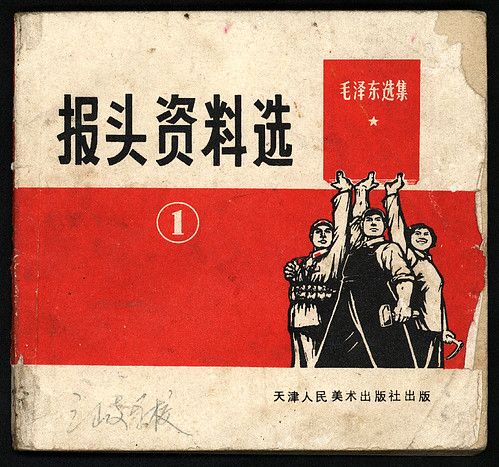I hope that you enjoyed your tour through the museum and I would very much appreciate any comments you have to make.
Sunday, June 5, 2011
Bibliography
"Cultural Revolution-Era Clip Art Book | Flickr - Photo Sharing!" Welcome to Flickr - Photo Sharing. Web. 05 June 2011. <http://www.flickr.com/photos/oldtasty/545399/>.
"David Hall and Alice in Wonderland." The Garden of Unearthly Delights. Blogspot, 23 Aug. 2008. Web. 05 June 2011. <http://lukefarookhi.blogspot.com/2008/08/david-hall-and-alice-in-wonderland.html>.
"Hold High the Great Red Banner of Mao Zedong to Wage the Great Proletarian Cultural Revolution to the End ..." Chinese Posters. 20 Oct. 2010. Web. 05 June 2011. <http://chineseposters.net/posters/e13-764.php>.
"Is Cantonese in Danger of Extinction? The Politics and Culture of Language Policy in China." China Notes: Superfluous Musings of a Chinese Historian. Blogspot, 20 Aug. 2010. Web. 05 June 2011. <http://chinamusictech.blogspot.com/2010/08/is-cantonese-in-danger-of-extinction.html>.
"March of the Red Guards." Redirect to Wellesley College Web Site. Web. 05 June 2011. <http://www.wellesley.edu/Polisci/wj/China/CRSongs/march.html>.
"May 2011." Precious. Web. 05 June 2011. <http://meganteamo.blogspot.com/2011_05_01_archive.html>.
"Red Guards Cultural Revolution Image | Flickr - Photo Sharing!" Welcome to Flickr - Photo Sharing. Flickr, 28 Oct. 2009. Web. 05 June 2011. <http://www.flickr.com/photos/zaruka/4054712766/>.
"The 60th Anniversary of the Founding of the PRC." ML Art Source. Web. 05 June 2011. <http://mlartsource.com/en/blog/35/the-60th-anniversary-of-the-people-s-republic-of-china>.
"21st Century Dazibao." Oklahoman in the Orient. 12 Nov. 2010. Web. 05 June 2011. <http://okie-east.blogspot.com/2010/11/21st-century-dazibao.html>.
(I apologize for not having indented every citation. Blogger would not allow me to do that.)
March of the Revolutionary Youth
March on, march forward, revolutionary youth
March on, march forward, revolutionary successors!
Victory is calling,
The red flag is guiding,
Along the great revolutionary path opened by our forefathers,
Push forth the wheel of the history.
March on, march forward, revolutionary successors!
Victory is calling,
The red flag is guiding,
Along the great revolutionary path opened by our forefathers,
Push forth the wheel of the history.
Mankind grows stronger in stormy wind and waves,
And revolution progresses in raging flames.
Facing the future,
Taking responsibility,
With our hot blood and a red heart,
Let us join with the workers and peasants,
To march on bravely toward our victory!
And revolution progresses in raging flames.
Facing the future,
Taking responsibility,
With our hot blood and a red heart,
Let us join with the workers and peasants,
To march on bravely toward our victory!
March on, march forward, revolutionary youth,
March on, march forward, revolutionary successors!
Hand in hand around the four oceans,
Heart with heart across the five continents,
For the world revolution,
We are determined to contribute our fighting youthful years.
March on, march forward, revolutionary successors!
Hand in hand around the four oceans,
Heart with heart across the five continents,
For the world revolution,
We are determined to contribute our fighting youthful years.
Revolutionary youths of the world, unite closely,
With all the oppressed people!
Support and learn from each other,
Millions as one,
Let us march forward shoulder to shoulder.
Hold high the revolutionary banner and fight bravely.
Victory will surely belong to people!
With all the oppressed people!
Support and learn from each other,
Millions as one,
Let us march forward shoulder to shoulder.
Hold high the revolutionary banner and fight bravely.
Victory will surely belong to people!
Here is an example of a song that was written during the Cultural Revolution. It is talking about the youth of the country, who are revolutionaries, and it shows their march to victory. It is for the Revolution and it is showing that, even though they were young, they wanted to help advance the Revolution.
Red Successors
 |
| The Red Successors showing their enthusiasm for a socialist society. |
Red Guard Uniform/Normal Everyday Wear
 |
| The uniform worn by the Red Guard. |
Mao's Little Red Book
 | |
| This picture shows the "Little Red Book" that practically every person in China carried during the Cultural Revolution |
This pictures is symbolizing the little red book that Mao gave all of his people during the Cultural Revolution. The book was full of quotes that Mao wanted his people to use in real life situations. It is the physical manifestation of his way of thinking. It plays a vital role in Ji-Li's life because she lives among people who carry it around as if it is a bible. And she is exposed to the way of life that Mao expects the people to live in.
Da-Zi-Bao
 |
| A building being covered by Da-Zi-Bao |
The da-zi-bao was a way to expose and embarrass people who were against Mao. It was a written form of an insult. It was meant to point out all of the bad things about a person, an item, a store, or anything for that matter. Students had to write them about their teachers. In Red Scarf Girl, Ji-Li has some trouble about writing one about her teacher for the first time and instead, she copies one from a newspaper article. We are also given the image that practically everything had something bad written about it and on it.
Red Guard
 | |
| This is an example of Red Guard Members. |
Propaganda..Again
 | ||
| "Raise the red flag of Mao high and let us make a revolution to the end" |
We can connect this to Red Scarf Girl because in the book, the children were very enthusiastic and believed in Mao; whereas, the parents of Ji-Li and the adults were reluctant and did not support Mao. They did not oppose of him either in order to survive his reign.
 | ||
| Alice seeing the Red Queen's servants painting her roses red. The Red Queen was not satisfied of the color and therefore demanded that they paint them red...or else.. OFF WITH THEIR HEADS. |
The Four Olds
Subscribe to:
Posts (Atom)


